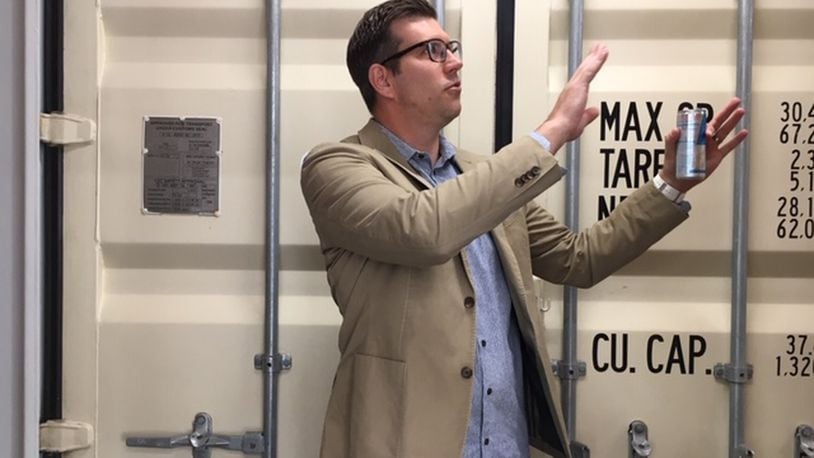And the company has done it first with its own office space at 23 Wayne Ave., placing support beams and a pair of connecting containers to link second-floor work spaces that had been separated.
The containers do not block a lower entrance to a parking garage within the building, and installing them took only six hours or so. Otherwise, a project like this could have taken months with more traditional methods.
Other Dayton clients are catching on. Jason Sheets, Moda4 owner and founder, said other local companies are embracing the same construction methods, although Sheets says he can’t name those customers yet.
”It’s a cool execution,” Sheets said. “But really, it was more about constructability and operations.”
“It’s also good for the city,” said Jamie Beth Loukinas, marketing director for Moda4. “Any time these old historic buildings get modernized, you’re giving them another 100 years or so. So it’s very good for Dayton.”
Why use storage containers in construction? Because it’s fast, relatively inexpensive and it works, Sheets said.
“When people are calling us, they know that we do more with less,” he said. “Budgets are usually tight. But they (clients) still want a very progressive, modern and thoughtful space. Whether that’s good or bad — the glass is half-full — we are in those situations a lot.”
He added: “Our team has gotten very good at stretching everyone’s dollar.”
A modular approach may help some localities address what in some areas has been a dramatic lack of affordable housing, Loukinas believes.
“A lot of people believe this is a really great trend,” she said. “It’s creative.”
The approach with work on the Arcade is different, however. Getting large shipping containers physically into the Arcade — never mind maneuvering them through the Arcade’s tight spaces — would be challenging, if not impossible, Sheets said.
“Instead, we ended up doing a very low-tech version of this, with off-the-shelf lumber parts to create systematic and incremental pods that can be adjusted, per the tenant needs,” he said.
The lead developer on that historic project, Baltimore’s Cross Street Partners, doesn’t typically look immediately for areas or aspects to cut when budgets are tight, Sheet said. Instead, Cross Street will explore new funding sources, which Sheets finds refreshing.
“It has been a long time, but projects like this don’t happen overnight,” Sheets said. “The developers are working tirelessly to get across the finish line.”
At the Arcade, Moda4 is responsible for design work on the commercial, retail and office space aspects of a very complicated project, one that connects eight or so buildings. Sandvick Architects, the Cleveland architect involved in the project, is focused on housing and historic preservation in the Arcade.
Moda4’s work goes well beyond the Arcade. The business is also working on the recently announced Avant Garde building in the 600 block of Third Street (the old Lotz Paper), home (or soon to be home) to Tangram Flex, JJR Solutions, Business Furniture and future restaurant and new business spaces.
The company has projects across the nation. Its portfolio includes the Goodwill Easter Seals Miami Valley campus, the Steam Plant, the Mills Morgan Tower in Beavercreek, Fuyao Glass America’s Taste of the World restaurant and many more.
About the Author
